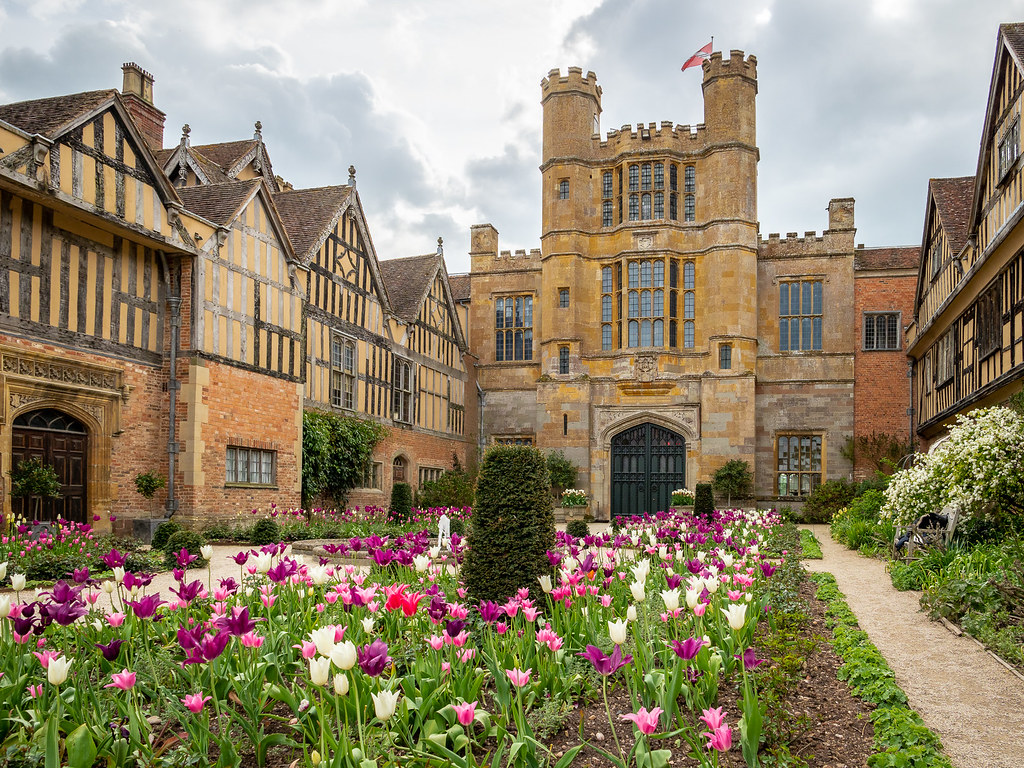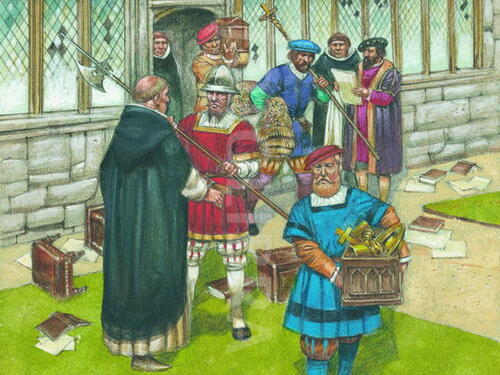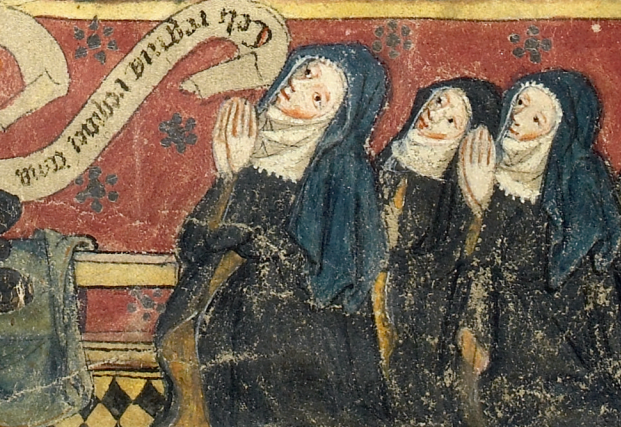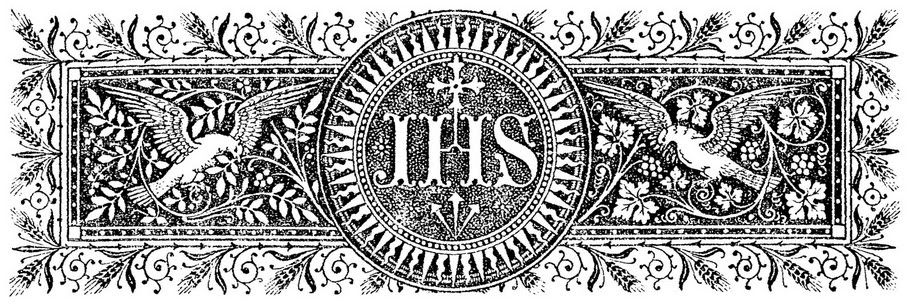This week’s writing prompt is this ancestor stayed home, some suggestions given were Homemakers, ancestors who lived their entire lives in one place, and someone who lived in a “home,” are just a few possibilities. I decided to throw it way back and talk about my 15th great-grandaunt Elizabeth Throckmorton, Abbess of Denny, and what became of monks and nuns at the dissolution of the monasteries by Henry VIII.
My Throckmorton ancestors are on my maternal side, my Underhill ancestors and family lines that I wrote about a few weeks ago.
Michael Carter writes about the dissolution at the English Heritage website:
Between 1536 and 1540, on the orders of Henry VIII, every single abbey and priory in England – some 800 in total – was dissolved, or forcibly closed. The shattered remains of monasteries such as Binham Priory, Buildwas Abbey, Gloucester Greyfriars, White Ladies nunnery and Shap Abbey are enduring witness to four years of willful and targeted destruction that led to permanent changes in the kingdom’s religion, politics, society and economics.
As a result, as many as 14,000 monks, nuns and friars, as well as countless monastic servants and tenants, had their lives changed forever, while about 200 people were executed for opposing the Dissolution.
Monasteries were especially vulnerable to attack, because of what they stood for. Many had close ties with the papacy and were home to monks and nuns who were loyal to traditional religion. Moreover, religious reformers who gained influence under Henry were especially critical of the monasteries. But monasteries were also at risk because many of them were extremely rich – and the king was often desperately short of money.
The Dissolution (also known as the Suppression) of the Monasteries proceeded in stages. The ‘lesser monasteries’ (those with an income of below £200 a year and fewer than 12 inmates) were dissolved in 1536. This was followed by further dissolutions that gathered pace in 1538, and by the middle of 1540 every monastery in England and Wales, many with histories stretching back to the Anglo-Saxons, had been dissolved.
A minority of monks, nuns and canons welcomed the dissolution of their monasteries and release from their vows. They included a small number of Evangelicals who actively embraced the reformers’ cause.
But for most monks and nuns, the arrival of Henry’s commissioners and the destruction of their monasteries was a distressing experience. One modern scholar has even argued that some developed symptoms of what we would now recognize as post-traumatic stress disorder. It is easy to understand why. The monasteries were not only their home; they were also at the center of their belief system. They provided status, self-identity, friendship and security. There are even reports of some monks dying within days of the suppression of their monasteries. (1)
Generally, at the closure of the monasteries and nunneries, most of the religious accepted the offer of a pension. This award was generally left to the discretion of the commissioners carrying out the closure rather than being a centrally set sum. The wealth of the monastery would be considered, with those in higher ‘management’ positions, such as an abbot, being offered an increased sum – partly, it has been argued, to entice them to go peacefully. Older members could also receive an increased amount as their chances of future employment were less than the younger members, who could potentially augment their pensions. (2)
Not all went away peacefully, some chose exile; others offered resistance to the changes. Several that resisted were hanged, drawn and quartered, while others ‘disappeared’ in prison and were starved to death. (2)
Not surprisingly, the nuns received smaller pensions, despite having less options for future employment than the monks. Many nuns returned to their family homes.
Elizabeth Throckmorton had been the Abbess of Poor Clares at Denny in Cambridgeshire since at least 1512 and perhaps earlier (3) she and the nuns under her charge were ones left without their religious house they had lived in together for many years. Denny Abbey had existed since the 12th century. It was inhabited by three different religious orders, the last being a convent of Poor Clares (Franciscan nuns).
Denny Abbey was located close to the main road between Ely and Cambridge and wayfarers and travelers would have sought food and alms from the nuns along their journey.

She was mentioned as “myne suster Dame Elisabeth abbas of Denny” in the 1518 will of her brother Sir Robert Throckmorton and she received a bequest of 20 shillings. (3)
Elizabeth was renowned for both her piety and her learning. In 1528 when Humphrey Monmouth, alderman of London, ran afoul of the authorities for distributing copies of Tyndale’s translation of Erasmus he was recorded as saying that he had lent his copy to Elizabeth, at her request. (4)
After the closure of the convent in 1539, she, like many other nuns, returned to her family home in Warwickshire. She returned to her family seat of Coughton Court in Warwickshire, which was now the home of her nephew Sir George Throckmorton. The Throckmortons remained a resolutely Catholic family. She and at least two or three nuns, most likely one of whom was her niece Margaret Throckmorton (daughter of Sir Robert Throckmorton) lived quietly in an upper floor at Coughton. They wore their brown monastic habits, they followed the Rule of the Order, and continued their conventual religious life the best they could.

Today you will find at Coughton Court, in the dining room, the ‘dole gate’ from Denny, a wooden hatch formerly set into the abbey’s front door, which is inscribed with the name of Dame Elizabeth and her monastery. At Denny it was used to distribute charity to the poor while ensuring the seclusion of the nuns. It may have been used at Coughton to provision Dame Elizabeth and her sister nuns while they maintained their strict enclosure. (1)
The actual words on the dole gate are ‘DOMINĀ ELISABETH THROGMARTON ABBATISSA DE DENNE DEVS LVITO’ which translates as ‘God absolve Dame Elisabeth Throgmarton, Abbess of Denny. (5)

The Coughton estate has been owned by the Throckmorton family since 1409, but the oldest section of the building is the Tudor gatehouse (shown here) dating from 1530.
Elizabeth Throckmorton was the daughter of Sir Thomas Throckmorton of Coughton Court, Warwickshire, England and Margaret Olney. The Throckmorton family (originally de Throckmorton) took its surname from the manor of Throckmorton in the parish of Fladbury, Worcestershire, which from the 12th century they held under the overlordship of the Bishop of Worcester. They acquired the manor of Coughton by marriage in the early 15th century. (6) Sir Thomas Throckmorton was the High Sheriff, Knight of the Shire, commissioned for the defense of the kingdom, appointed steward of all castles, manors, etc., controlled by the Bishop of Worcester and high sheriff of the counties of Warwick and Leicester.
Elizabeth Throckmorton, Abbey of Denny, had numerous siblings including my direct ancestor Margery Throckmorton (married Richard Middlemore). (7)
A brass plaque in the church at Coughton, Warwickshire commemorates the abbess’s death on 13 Jan 1547. (3)
References:
- Carter, Michael What Became of the Monks and Nuns at the Dissolution? english-heritage.org.uk
- Q&A: Where did the monks go after the dissolution of the monasteries? historyextra.com
- Erler, Mary C. Women, Reading, and Piety in Late Medieval England Cambridge University Press, 9 Mar 2006 Google Books.
- Peter G. Bietenholz, Thomas Brian Deutscher Contemporaries of Erasmus: A Biographical Register of the Renaissance and Reformation, Volumes 1-3 University of Toronto Press, 1 Jan 2003 pg. 321 Google Books.
- National Trust UK, Coughton Court. nationaltrust.org.uk
- Sir George Throckmorton. en.wikipedia.org
- Roberts, Gary Boyd, The Royal Descents of 600 Immigrants to the American Colonies or the United States (2 vols.), Baltimore: Genealogical Publishing Co. (2008), 558.
To learn more about Denny Abbey:
- DENNY ABBEY AND THE FARMLAND MUSEUM. english-heritage.org.uk
- Denny Abbey. en.wikipedia.org
- Denny Abbey Farmland Museum. dennyfarmlandmuseum.org.uk
To learn more about Coughton Court:
- National Trust – Coughton Court. Facebook for Coughton Court.
- COUGHTON COURT. coughtoncourt.co.uk
- Coughton Court. History, tourist information, and nearby accommodation. britainexpress.com
To learn more about the Throckmorton family:
- THE THROCKMORTON FAMILY OF COUGHTON COURT. ourwarwickshire.org.uk
- Coughton Court Gunpowder Plot and Gardens. Chapter 4: History of the Throckmortons. tudortimes.co.uk
- Browning, Charles Henry. (1898). The Magna Charta Barons and Their American Descendants with the Pedigrees of the Founders of the Order of Runnemede Deduced from the Sureties for the Enforcement of the Statutes of the Magna Charta of King John, page 199.
If you’d like to learn more about the 52 Ancestors in 52 Weeks project, please visit here:
Or join the Facebook group Generations Cafe.
If you use any information from my blog posts as a reference or source, please give credit and provide a link back to my work that you are referencing. Unless otherwise noted, my work is © Anna A. Kasper 2011-2024. All rights reserved. Thank you.



